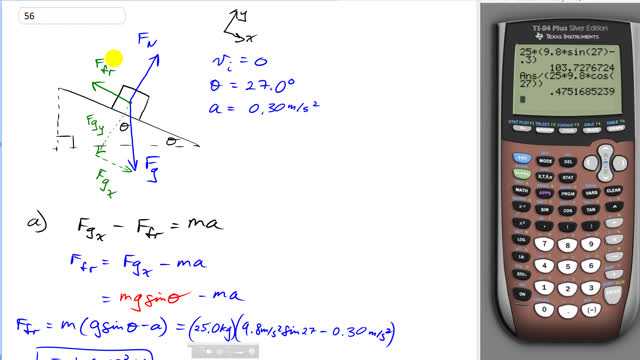
A 25.0-kg box is released on a incline and accelerates down the incline at . Find the friction force impeding its motion. What is the coefficient of kinetic friction?
- up the ramp.

In order to watch this solution you need to have a subscription.
This is Giancoli Answers with Mr. Dychko. This box initially has a speed of zero and it's put on this incline and it's sliding down, has an acceleration of 0.3 meter per second down the ramp and friction is going against the velocity opposite to the direction of velocity, velocity is down the ramp. And so, that makes it go up the ramp. And we have gravity straight down and we have the normal force perpendicular to the ramp and we'll take the axis, rotate it a little bit. And have x positive down the ramp and y positive perpendicularly away from the surface of the ramp. And so, first question is, find the friction force. And so, the x component of gravity acting downwards minus the friction force going up the ramp, that is the net force in the x direction which makes it equal to ma. And we can solve for the friction force by... We can take this to the right hand side and take this one to the left hand side. So, add friction to both sides, subtract ma from both sides and then switch the sides around, you get the friction force equals Fgx minus ma. And Fgx is the opposite leg of this gravity force triangle. And so, that means we use sine theta times Fg to get it and Fg is mg. And so, we have this substitution here of mg sine theta in place of Fgx. And we can factor out the m's just to be slick. And we have force of friction equals m times bracket g sine theta minus a plus 25 kilograms times 9.8 meters per second squared times sine 27 degrees angle of incline minus 0.3 meters per second squared acceleration which gives 1.0 times 10 to the 2 newtons with 2 significant figures, that's the friction force. And then we'll calculate what coefficient of kinetic friction there must be if that's going to be the friction force then. So, friction force is muK times normal force. And normal force, we can see from the diagram has to be equal to the y component of gravity because there's no acceleration perpendicular to the ramp. And so, the up forces have to equal total down forces but there's only one in each direction. So, the normal force equals the y component of gravity. And the y component of gravity is the adjacent leg of this gravity triangle. And so, that means we use cosine theta times mg to get fgy. And so, that's what I wrote here, mg cos theta in place of fgy. So, that means muK mg cos theta is force of friction which is what I wrote here. And we'll divide both sides by everything except but the muK. So, divided by mg cos theta, both sides. Cancels on the left leaving us with muK, coefficient of kinetic friction is friction force divided by mg cos theta. So, it's 103.73 newtons divided by 25 kilograms times 9.8 newtons per kilogram times cos 27 which is 0.4 8. And there are no units for coefficients of friction.
Should the answer to part a be negative because it is working against an object moving in the positive x direction?
Hi tucker, thank you for the question. I'd have to agree with you that the best answer would be with a negative. The way I set up the net force formula $F_\textrm{gx} - F_\textrm{fr} = ma$ where I put the negative in the formula means that each force terms is a magnitude, which is why the answer turned out positive. The negative was put into the formula. Sometimes I find this it easier to work with forces/velocities by putting negatives in the formulas, but I can see why this might be confusing for students not used to that approach.
All the best,
Shaun